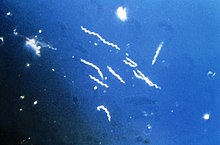Borrelia burgdorferi sensu stricto is a bacterial species of the spirochete class in the genus Borrelia, and is one of the caucative agents of Lyme disease in humans.[1][2] Along with a few similar genospecies, some of which also cause Lyme disease, it makes up the species complex of Borrelia burgdorferi sensu lato. The complex currently comprises 20 accepted and 3 proposed genospecies.[2] B. burgdorferi sensu stricto exists in North America and Eurasia and until 2016 was the only known cause of Lyme disease in North America.[3][4][2] Borrelia species are gram-negative.[5]
| Borrelia burgdorferi | |
|---|---|
 | |
| Borrelia burgdorferi | |
| Scientific classification | |
| Domain: | Bacteria |
| Phylum: | Spirochaetes |
| Order: | Spirochaetales |
| Family: | Spirochaetaceae |
| Genus: | Borrelia |
| Species: | B. burgdorferi |
Borrelia burgdorferi is named after the researcher Willy Burgdorfer, who first isolated the bacterium in 1982.[6]
Morphology[edit]
B. burgdorferi resembles other spirochetes in that it has an outer membrane and inner membrane with a thin layer of peptidoglycanin between. However, the outer membrane lacks lipopolysaccharide. Its shape is a flat wave. It is about 0.3 μm wide and 5 to 20 μm in length.[7]
B. burgdorferi is a microaerobic, motile spirochete with seven to 11 bundled perisplasmic flagella set at each end that allow the bacterium to move in low- and high-viscosity media alike, which is related to its high virulence factor.[8]
Metabolism[edit]
B. burgdorferi is a slow-growing microaerophilic spirochete with a doubling time of 24 to 48 hours.[9]
https://en.wikipedia.org/wiki/Borrelia_burgdorferi
No comments:
Post a Comment